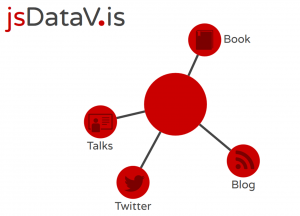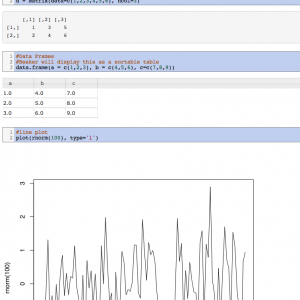Deeplearning4j Documentation
Posted by Armando Brito Mendes | Filed under materiais para profissionais, software
O site de um pacote java para deeplearing com montes de info. sobre redes neuronais e afins.
- How To
- Quickstart: Running Examples and DL4J in Your Projects
- Comprehensive Setup Guide
- Build Locally From Master
- Contribute to DL4J (Developer Guide)
- Choose a Neural Net
- Use the Maven Build Tool
- Vectorize Data With Canova
- Build a Data Pipeline
- Run Benchmarks
- Configure DL4J in Ivy, Gradle, SBT etc
- Find a DL4J Class or Method
- Save and Load Models
- Interpret Neural Net Output
- Visualize Data with t-SNE
- Swap CPUs for GPUs
- Customize an Image Pipeline
- Perform Regression With Neural Nets
- Troubleshoot Training & Select Network Hyperparameters
- Visualize, Monitor and Debug Network Learning
- Speed Up Spark With Native Binaries
- Build a Recommendation Engine With DL4J
- Use Recurrent Networks in DL4J
- Build Complex Network Architectures with Computation Graph
- Train Networks using Early Stopping
- Download Snapshots With Maven
- Customize a Loss Function
- Introduction to Neural Networks
- Multilayer Neural Nets
- Tutorials
- Datasets
- Scaleout
- Text
- Resources
- DL4J, Torch7, Theano and Caffe
- Glossary of Terms for Deep Learning and Neural Nets
- Deep Learning’s Accuracy
- DataVec: ETL for ML
- ND4J Backends: How They Work
- Model Zoo
- Unsupervised Learning: Use Cases
- Eigenvectors, PCA, Covariance and Entropy
- Thought Vectors, AI and NLP
- Questions to Ask When Applying DL
- AI, Machine Learning and Deep Learning
- DL and Reinforcement Learning
- Javadoc: DL4J Methods and Classes
- Canova Javadoc: Canova Methods and Classes
- ND4J User Guide
- ND4J Javadoc
- Scala, Spark and Deep Learning
- Further Reading on Deep Learning
- Deep Learning in Other Languages
- Use Cases
- Architecture
- Features
- Roadmap
- About
- Open Data
- Latest Release Notes
Guardar
Tags: análise de dados, big data, data mining, desnvolvimento de software, machine learning
Best Data Science Learning podcasts
Posted by Armando Brito Mendes | Filed under lições, materiais ensino, materiais para profissionais, videos
Muito bons podcasts tem temas introdutórios
We present the top 12 Data Science & Machine Learning related Podcasts by popularity on iTunes. Check out latest episodes to stay up-to-date & become a part of the data conversations!
By Bhavya Geethika Peddibhotla.
Learn Data science the new way by listening to these compelling story tellers, interviewers, educators and experts in the field. Data suggests that podcasting about Data Science is only growing!
Tags: análise de dados, big data, data mining, desnvolvimento de software, Estat Descritiva, machine learning
Data Visualization with JavaScript
Posted by Armando Brito Mendes | Filed under estatística, SAD - DSS, software, visualização
Um bom e-book sobre como construir visualizações com JavaScript
It’s getting hard to ignore the importance of data in our lives. Data is critical to the largest social organizations in human history. It can affect even the least consequential of our everyday decisions. And its collection has widespread geopolitical implications. Yet it also seems to be getting easier to ignore the data itself. One estimate suggests that 99.5% of the data our systems collect goes to waste. No one ever analyzes it effectively.
Data visualization is a tool that addresses this gap.
Effective visualizations clarify; they transform collections of abstract artifacts (otherwise known as numbers) into shapes and forms that viewers quickly grasp and understand. The best visualizations, in fact, impart this understanding subconsciously. Viewers comprehend the data immediately—without thinking. Such presentations free the viewer to more fully consider the implications of the data: the stories it tells, the insights it reveals, or even the warnings it offers. That, of course, defines the best kind of communication.
If you’re developing web sites or web applications today, there’s a good chance you have data to communicate, and that data may be begging for a good visualization. But how do you know what kind of visualization is appropriate? And, even more importantly, how do you actually create one? Answers to those very questions are the core of this book. In the chapters that follow, we explore dozens of different visualizations and visualization techniques and tool kits. Each example discusses the appropriateness of the visualization (and suggests possible alternatives) and provides step-by-step instructions for including the visualization in your own web pages.
To give you a better idea of what to expect from the book, here’s a quick description of what the book is, and what it is not.
Tags: belo, data mining, desnvolvimento de software
PlotDevice: Draw with Python
Posted by Armando Brito Mendes | Filed under estatística, materiais para profissionais, software, visualização
Uma biblioteca de funções em Pyton para construir visualizações de dados.
You’ve been able to visualize data with Python for a while, but Mac application PlotDevice from Christian Swinehart couples code and graphics more tightly. Write code on the right. Watch graphics change on the right.
The application gives you everything you need to start writing programs that draw to a virtual canvas. It features a text editor with syntax highlighting and tab completion plus a zoomable graphics viewer and a variety of export options.
PlotDevice’s simple but comprehensive set of graphics commands will be familiar to users of similar graphics tools like NodeBox or Processing. And if you’re new to programming, you’ll find there’s nothing better than being able to see the results of your code as you learn to think like a computer.
Looks promising. Although when I downloaded it and tried to run it, nothing happened. I’m guessing there’s still compatibility issues to iron out at version 0.9.4. Hopefully that clears up soon. [via Waxy]
Tags: big data, data mining, desnvolvimento de software, Estat Descritiva
What is probabilistic programming?
Posted by Armando Brito Mendes | Filed under materiais para profissionais, software
Uma nova forma de trabalhar com modelos Bayesianos!
«
In this post, I introduce the emerging area of probabilistic programming, showing how probabilistic programs will hopefully make it easier to perform Bayesian-style machine learning, among other applications. Probabilistic programming is an exciting, and growing, area of research, with fantastic people in both AI/ML and PL working together and making big strides. PL methods — including formal semantics, optimization techniques, and forms of static analysis — have proven very useful in advancing this area forward.
Tags: bioinformatica, data mining, decisão médica, definição, desnvolvimento de software, qualidade
Why Content Marketing Fails
Posted by Armando Brito Mendes | Filed under materiais para profissionais, planeamento, software

Boa apresentação de slides para quem se interessa para criar negócios de conteúdos na web. Vejam igualmente as formas de visualização de dados usadas.
Why Content Marketing Fails Presentation Transcript
- Rand Fishkin, Wizard of Moz | @randfish | rand@moz.com Why Content Marketing Fails
- Download this Slide Deck bit.ly/mozcontentfail
- Failure Sucks
- Most Content Efforts Will Fail Spike of hope Flatline of nope
- You’ll Invest with the Best of Intentions
- You’ll Launch with Excitement
- And it Will Suck
- And You Won’t Know Why
- Why Your Content Marketing Will Fail 5 Reasons
- You Believed the Biggest Myth Content Marketing Ever Told the World #1
- We Imagine Content Marketing Works Like This… Let’s go see what’s on the Internet today, shall we?
- I wonder what this post Kieran tweeted is all about.
- That was an interesting. I should sign up for this free ebook download while I’m here!
- And I’ll just fill out their contact form with my information….
- Oh! Better not forget to follow all their social profiles while I’m at it.
- You might laugh, but a lot of companies invest in content marketing on the assumption that this is how it works! Me make content. Humans click. Them buy. Me get money.
- In Reality, It Works Like This: Let’s see what’s on Hacker News… Meh.
- How about Facebook? Oh, right. Baby pictures.
- Let’s try Twitter. Meh.
- Maybe Google+? Actually… This looks kinda interesting.
- After seeing 400+ links I could have clicked, I finally chose this one. It’s a good article, and this example, naturally, resonated
- I wonder why I like this blog so much? About a week later, I caught a link to Beardbrand’s blog.
- No magic trick to grow a thicker beard?! Dammit! I’d followed them on Google+, so I watched this video they shared, too.
- When my lovely wife told me that I might need to look into some mustache wax, I thought of Beardbrand. But I couldn’t remember their name! Lovely Wife Imminent need for mustache wax Who were those guys that made the cool beard stuff?
- So, naturally, I searched Google: Nope Nope Nope Yes!!
- A Perfect Match!
- Say goodbye bushy handlebars!
- This is How Content Marketing Really Works: Caveman Rand explain.
- This is How Content Marketing Really Works: Me Make Content. Humans click. If them like, them remember. Maybe them see more content I make. Visit again. Me build trust, relationship with humans. When them need me product, them come back.
- Content marketing not about convert 1st visit. Or 2nd. Or 3rd. Only foolish humans think it work like this.
- Content marketing about earning familiarity, trust, and relationship.
- Maybe sale come. Maybe not. Smart cave marketer no care. Smart cave marketer know every visit chance to build relationship. Maybe earn fan. That good enough.
- The Obligation Rests on Marketers to Set the Right Expectations with Our Teams & Clients
- You Made Content Without a Community #2
- Does Content Spread Simply Because It’s Really, Really Good? If this content’s really good, it’ll just spread “virally,” right guys?
- OK, Probably Not Ha! That’s a good one, Rand!
- In My Experience, Content Spreads Because It Inspires a Community
- It Reinforces a Belief
- Refutes an Opposing Argument
- Starts (or Renews) a Passionate Discussion
- Is in Someone’s Financial/Promotional Interests
- Leverages Group Inclusion Dynamics
- Makes the Sharer Look Smart/Important/Worldly/Etc
- “Good Enough” Content Often Performs Well when a Community Is Behind It
- Only the Best 0.1% of Content Can Go “Viral” without a Pre-existing Community
- Don’t Bet Your Marketing on Being the 1 in 1,000
- Before you create content, ask the question: “Who will support & amplify this content and why?”
- You Invested in Content Creation, But Not in its Amplification #3
- Content Must Reach People in Order to Reach Its Potential
- Channels for Reaching the Right People Depend on Your Audience
- Most Amplification Methods Fall Into These Three Buckets: Broadcast 1:1 Paid Promotion
- 1) Broadcast (often via Social Media, Email, or through Events)
- 2) 1:1 Outreach (via Social, Email, or In- Person)
- 3) Paid Amplification (many varieties)
- A basic process for getting content amplification right:
- STEP 1: Find Successful Content in Your Niche http://buzzsumo.com
- STEP 2(a): Find Where It’s Being Shared http://buzzsumo.com
- STEP 2(b): Go Beyond Social Networks Google Search and https://freshwebexplorer.moz.com/
- STEP 2(c): Find Who’s Doing the Sharing http://buzzsumo.com
- STEP 2(c): Find Who’s Doing the Sharing http://www.blindfiveyearold.com/ripples-bookmarklet
- STEP 3: Copy What’s Working For Them Via http://followerwonk.com
- STEP 4: Build Relationships with Those Who Can Help http://www.slideshare.net/RickTRamos1/why-do-peopleshareonline
- Don’t Treat Amplification as “Fire & Forget.” Experiment, Learn, & Apply. Via http://bit.ly
- Think of Each Channel Like a Muscle to Be Flexed & Strengthened Regularly
- Don’t Forget to Leverage What is Still the Most Powerful Sharing Channel (according to NYT): http://www.slideshare.net/RickTRamos1/why-do-peopleshareonline
- You Ignored Content’s Most Powerful Channel: SEO #4
- Google Search Has Grown Massively ~6 Billion Searches/Day! http://www.statisticbrain.com/google-searches/
- While Search Traffic is Distributed, Social is Highly Concentrated http://www.simplereach.com/blog/facebook-continues-to-be-the-biggest-driver-of-social-traffic/
- You Might Have Seen Re/Code & Buzzfeed Claiming Google Search Traffic Was Dead http://recode.net/2014/02/02/the-year-facebook-blew-past-google/
- Here’s Define Media Group refuting that with data from 87 publishers & 48 billion pageviews http://www.definemg.com/hey-buzzfeed-search-traffic-is-doing-just-fine/
- SEO is Also Critical Because of Intent “Do things” mode “Browse” mode
- When Done Right, Content Marketing is the Rising Tide that Lifts the SEO Ships Without content marketing, it’s incredibly hard to earn the types of links that will confer domain authority & rankings in search engines.
- When Done Right, Content Marketing is the Rising Tide that Lifts the SEO Ships But as content on a site earns links, it helps every other page on that domain rank better in the search engines, lifting the tide!
- At the Very Least, Do Your Keyword Research Be aware that AdWords may not show you all the relevant keywords: http://moz.com/blog/be-careful-using-adwords-for-keyword-research
- Better Yet – Gain a Deep Understanding of How SEO & Content Work Together 4 Posts I’d Recommend: • The Convergence of SEO & Content Marketing • Link Building vs. Content Marketing • How to Build a Content Marketing Strategy • Build & Operate a Content Marketing Machine
- You Gave Up Way Too Soon #5
- The 0.1% Always Look Like Overnight Successes
- In Reality, It Looks More Like This: Geraldine’s Travel Blog: http://everywhereist.com
- Geraldine started her blog in 2009 In Reality, It Looks More Like This:
- For 2 years, she never broke 100 visits/day. In Reality, It Looks More Like This:
- Then she had a few posts get some attention In Reality, It Looks More Like This:
- But traffic fell back down soon after. In Reality, It Looks More Like This:
- This is where most people give up. In Reality, It Looks More Like This:
- These days, she gets 100,000+ visits each month In Reality, It Looks More Like This:
- The Price of Success is Failure after Failure after Failure * Hopefully, each of those failures provides an opportunity to learn. *
- Why Content Marketing Fails Rand Fishkin, Wizard of Moz | @randfish | rand@moz.com bit.ly/mozcontentfail
Tags: b-learning, belo, desnvolvimento de software
Using Open Source Technology in Higher Education
Posted by Armando Brito Mendes | Filed under estatística, software
Using R for Basic Cross Tabulation Analysis: Part Three, Using the xtabs Function
crosstabsrr programmingr statisticstable analysis
Using R to Work with GSS Survey Data: Cross Tabulation Tables
chi squaredcross tablescrosstabsrr programmingr statisticstable analysis
R Tutorial: Using R to Work With Datasets From the NORC General Social Science Survey
create csv filefile conversionrr programmingr statisticsr tutorialread spss filesresearch
How to Set Up SSH to Remotely Control Your Raspberry Pi
mmand lineraspberry piraspberry pi computingRaspberry Pi Software Configuationremote access with sshset up sshsshterminal program
Tags: análise de dados, data mining, desnvolvimento de software, Estat Descritiva, R-software, software estatístico
Vector maps on the web with Mapbox GL
Posted by Armando Brito Mendes | Filed under mapas SIG's, materiais para profissionais, software, visualização
Online mapping just got an upgrade:
Announcing Mapbox GL JS — a fast and powerful new system for web maps. Mapbox GL JS is a client-side renderer, so it uses JavaScript and WebGL to dynamically draw data with the speed and smoothness of a video game. Instead of fixing styles and zoom levels at the server level, Mapbox GL puts power in JavaScript, allowing for dynamic styling and freeform interactivity.
For the non-developers: Online maps are typically stored pre-made on a server, in the form of a bunch of image files that are stitched together when you zoom in and out of a map. So developers have to periodically update the image files if they want their base maps to change. It’s a hassle, which is why base maps often look similar. With Mapbox GL, making changes is easier because the development pipeline is shorter.
More details on the JavaScript library here.
Tags: desnvolvimento de software, mapas
BEAKER The data scientist’s laboratory
Posted by Armando Brito Mendes | Filed under materiais para profissionais, software
Beaker is a code notebook that allows you to analyze, visualize, and document data using multiple programming languages including Python, R, Groovy, Julia, and Node. Beaker’s plugin-based polyglot architecture enables you to seamlessly switch between languages and add support for new languages.
Tags: data mining, desnvolvimento de software, R-software
Using R in Nonparametric Statistical Analysis
Posted by Armando Brito Mendes | Filed under estatística, materiais ensino, software
- Using R in Nonparametric Statistical Analysis: The Kruskall-Wallace Test for One-Way Analysis of Variance
- Using R in Nonparametic Statistical Analysis: The Binomial Sign Test
Tags: desnvolvimento de software, R-software, software estatístico




